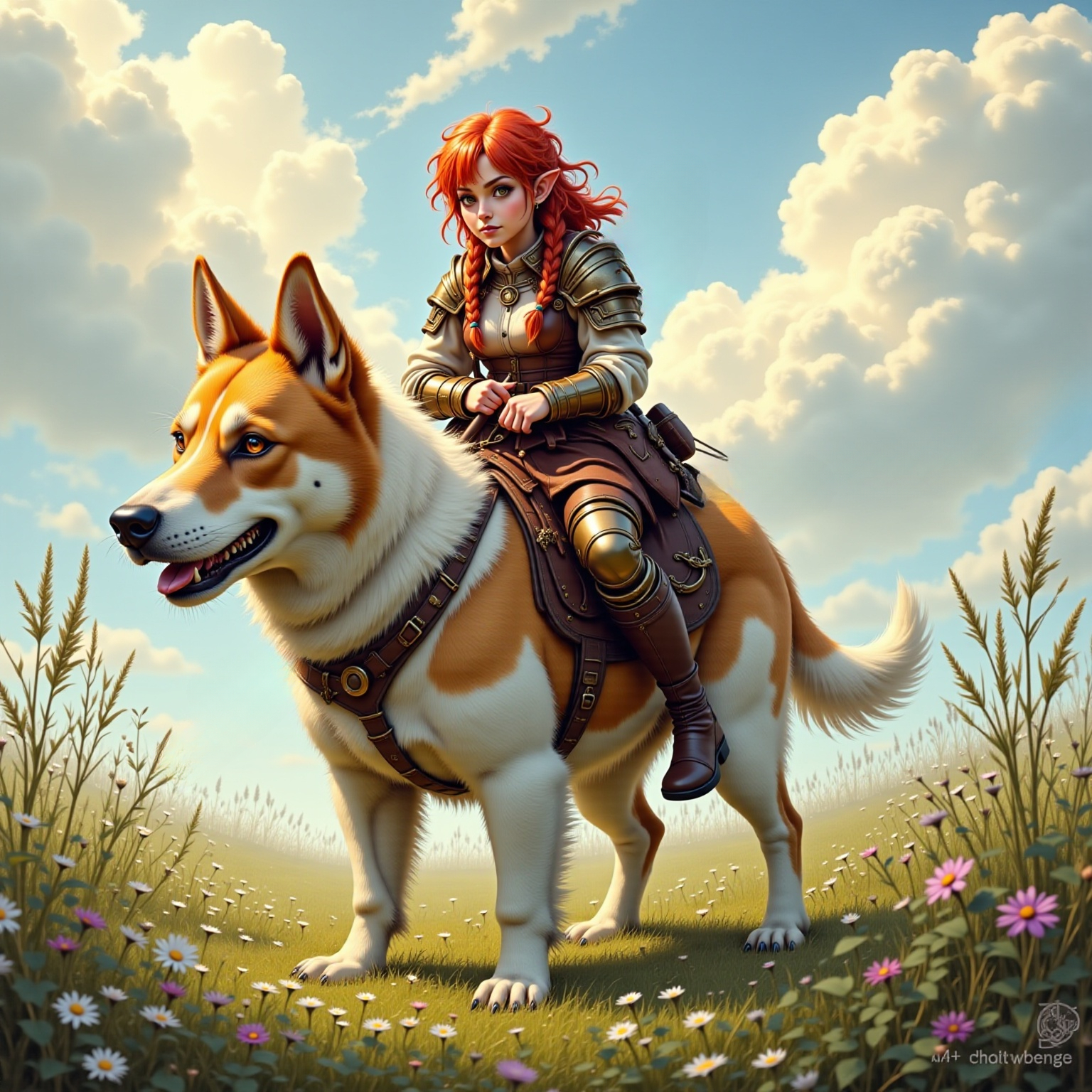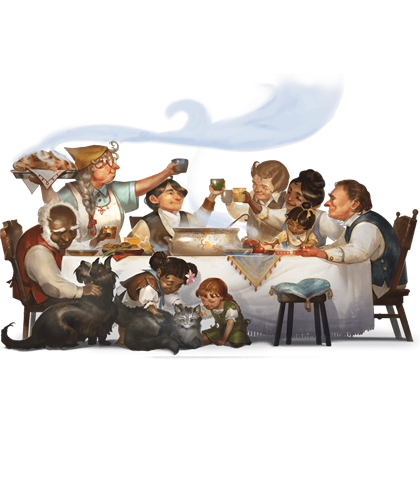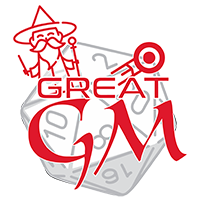Tygga Cheeryberry
Tygga Cheeryberry
| Level | 5 |
| Background | Scout Leader |
| Size | Small |
| Species | Halfling |
Officer
| Subclass | Equestrian |
| Level | 5 |
| Hit dice | 5/5 |
| 1d8+0 | |
STR 8
-1
STR save:
-1
DEX 15
+2
DEX save:
+2
CON 10
+0
CON save:
+0
INT 18
+4
INT save:
+7
WIS 12
+1
WIS save:
+4
CHA 13
+1
CHA save:
+1
Initiative (DEX)
+2
Speed
30 ft
Passive Perception
11
Heroic Inspiration
Armor Class (AC)
14
Studded Leather
Armor Class w/Shield
16
Shield
Hit Points
28 / 28
Death Saves
Succeeded
Failed
Exhaustion
Attacks
| W | Pr | Weapon / Attack | AB | Abi | Dmg | Dmg Type |
|---|---|---|---|---|---|---|
| Rapier | +5 | DEX | 1d8+2 | piercing | ||
| Properties: Finesse | Vex | |||||
| Snaplock Pistol | +5 | DEX | 1d10+2 | piercing or bludgeoning | ||
| Properties: Light, 30/120 range, loading, Fatal shot 1d12+15 | Vex | |||||
Armor
( AC Mod: +2 )
| W | T | Armor | AC | D | Properties |
|---|---|---|---|---|---|
| Studded Leather | 12 | ||||
| Shield | +2 |
Skills
| P/E | Bonus | Skill | Abi |
|---|---|---|---|
| +2 | Acrobatics | DEX | |
| +7 | Animal Handling | WIS | |
| +4 | Arcana | INT | |
| -1 | Athletics | STR | |
| +4 | Deception | CHA | |
| +7 | History | INT | |
| +1 | Insight | WIS | |
| +1 | Intimidation | CHA | |
| +10 | Investigation | INT | |
| +1 | Medicine | WIS | |
| +7 | Nature | INT | |
| +1 | Perception | WIS | |
| +1 | Performance | CHA | |
| +4 | Persuasion | CHA | |
| +4 | Religion | INT | |
| +2 | Sleight of Hand | DEX | |
| +5 | Stealth | DEX | |
| +4 | Survival | WIS | |
| +5 | Leatherworker's Tools | DEX |
+6
Expertise Bonus |
+3
Proficiency Bonus |
Spell Book
Money
Copper: 0,
Silver: 0,
Electrum: 0,
Gold: 50,
Platinum: 0
Treasure and Equipment
Studded Leather, Shield, Rapier, Snaplock Pistol
Proficiencies, Languages, and Talents
Common, halfling, gnomish
Features & Traits
D&D Free Rules (2024)
Halfling
HUMANOID
As a Halfling, you have these special traits.
Cherished and guided by gods who value life, home, and hearth, halflings gravitate toward bucolic havens where family and community help shape their lives. That said, many halflings possess a brave and adventurous spirit that leads them on journeys of discovery, affording them the chance to explore a bigger world and make new friends along the way. Their size—similar to that of a human child—helps them pass through crowds unnoticed and slip through tight spaces.
Anyone who has spent time around halflings, particularly halfling adventurers, has likely witnessed the storied “luck of the halflings” in action. When a halfling is in mortal danger, an unseen force seems to intervene on the halfling’s behalf. Many halflings believe in the power of luck, and they attribute their unusual gift to the stars, totems, tokens or various superstitions.
Found mostly on the island of the High Thistle where they have established a merry kingdom away from the wars and strife of the other continents.
Halfling Traits
Size: Small (about 2–3 feet tall)
Speed: 30 feet
As a Halfling, you have these special traits.
Brave. You have Advantage on saving throws you make to avoid or end the Frightened condition.
Halfling Nimbleness. You can move through the space of any creature that is a size larger than you, but you can’t stop in the same space.
Luck. When you roll a 1 on the d20 of a D20 Test, you can reroll the die, and you must use the new roll.
Naturally Stealthy. You can take the Hide action even when you are obscured only by a creature that is at least one size larger than you.
Custom Background: Scout Leader
Skilled. You gain proficiency in any combination of three skills or tools of your choice.
Attack At Will At level 1, use an Action to choose an ally within a 30 ft. radius and they can use an weapon attack action by using their reaction.
Intelligent Defense.At level 1, you can add your Intelligence bonus as your AC bonus if higher than your Dexterity.
Tactical Analysis
You can use a Bonus action to learn a number of attributes of a creature equal to your Proficiency Bonus from the list below:
- One Ability Score
- Attack bonus
- Hit points
- Armor Class
- Damage vulnerabilities, immunities or resistances
- Condition immunities
Mounted Officer. You've trained your mount to work with you when you're in combat. It uses your Intelligence Modifier and Proficiency Bonus for their Attack and Damage Rolls. Your mount acts on your Initiative can move and make Attack Rolls. You can Disengage or Dash with your mount as a Bonus Action. To get these benefits you must be riding your mount and can't have the Incapacitated condition.
When you acquire a new mount or lose your mount you'll have to spent a month in downtime to train a new mount.
Advanced Training. You can train your mount to perform actions on certain triggers. For example, you can train it to bring you to a party member when you're incapacitated or have it wait for you until you whistle. You can have a number of triggers equal to your Intelligence Modifier.
Extra Attack. You can attack twice instead of once whenever you take the Attack action on your turn.
Expertise. Choose 2 skills to become an expert in. You double your Proficiency Bonus for this chosen skill.
Mounted Combatant.
- Mounted Strike. While mounted, you have Advantage on attack rolls against any unmounted creature within 5 feet of your mount that is at least one size smaller than the mount.
- Leap Aside. If your mount is subjected to an effect that allows it to make a Dexterity saving throw to take only half damage, it instead takes no damage if it succeeds on the saving throw and only half damage if it fails. For your mount to gain this benefit, you must be riding it, and neither of you can have the Incapacitated condition.
- Veer. While mounted, you can force an attack that hits your mount to hit you instead if you don’t have the Incapacitated condition.
Backstory
You were born in the distant land of Windemere, in the country of the High King of the Thistles. You grew up in a happy little halfling village with much singing and feasting, largely oblivious to the dangers of the world. You have 13 siblings and have always had a knack for ordering them around! Becoming a part of the Brambling Scouts at a young age you were known for your natural leadership, intelligence and charisma.
When you were young you were given a puppy to raise as your trusted mount and friend. You named him Potpie after his favorite food and the coloring of his coat. Soon he grew up as a strong and powerful wardog and could easily carry you on his back.
However, your time in the Brambling Scouts is coming to an end and you have been given a quest to be raised to knighthood in the Order of the Bramble. They want you to take a boat to the distant city of Mori and to find out more out their Kingdom. Meet with their leader and bring a gift of a jar of the finest honey from the apiaries. Such a fine gift is sure to lead to amicable relations.
You got on the boat with a sailor by the name of Gallivan and set out with the currents to the west. Reaching the distant continent after a month at sea, you saw smoke in the distance as if a great fire was roaring on the land. After you got close you noticed it escaped from great chimneys billowing black dirty smoke into the clean air.
Disembarking in the large harbor you set off into the city trying to find the King of this realm but everywhere you asked you were only met with strange glances and laughter. They said you must find the Emperor in his palace so you set out to the largest building you could find!
Unfortunately a bunch of thieves tried to rob you in the alleys while you traveled towards the large palace. You almost died fighting them off but a friendly Goblin came to your rescue! Quickly dispatching them he explained to you that the Emperor doesn't see just anyone and explained his plight of his organisation, the Red Fist, and that of the poor of the city.
A new quest has come to you! Speak with the Emperor and explain to him of the plight of his people and surely he will see reason!
When you were young you were given a puppy to raise as your trusted mount and friend. You named him Potpie after his favorite food and the coloring of his coat. Soon he grew up as a strong and powerful wardog and could easily carry you on his back.
However, your time in the Brambling Scouts is coming to an end and you have been given a quest to be raised to knighthood in the Order of the Bramble. They want you to take a boat to the distant city of Mori and to find out more out their Kingdom. Meet with their leader and bring a gift of a jar of the finest honey from the apiaries. Such a fine gift is sure to lead to amicable relations.
You got on the boat with a sailor by the name of Gallivan and set out with the currents to the west. Reaching the distant continent after a month at sea, you saw smoke in the distance as if a great fire was roaring on the land. After you got close you noticed it escaped from great chimneys billowing black dirty smoke into the clean air.
Disembarking in the large harbor you set off into the city trying to find the King of this realm but everywhere you asked you were only met with strange glances and laughter. They said you must find the Emperor in his palace so you set out to the largest building you could find!
Unfortunately a bunch of thieves tried to rob you in the alleys while you traveled towards the large palace. You almost died fighting them off but a friendly Goblin came to your rescue! Quickly dispatching them he explained to you that the Emperor doesn't see just anyone and explained his plight of his organisation, the Red Fist, and that of the poor of the city.
A new quest has come to you! Speak with the Emperor and explain to him of the plight of his people and surely he will see reason!
Allies & Organizations
The Red Fist
Adventuring Motivation
To gain an audience with the Emperor.
Notes
Has a wardog mount. Tries to stay out of battle and prefer to buff other characters. Will use her pistol to fire at enemies or use Potpie to bite and knock them prone to strike with her rapier. Will gain advantage against Medium and smaller when mounted.
Outside of combat has good social skills.
Very naive and unfamiliar with the brutal culture of the Empire.
Outside of combat has good social skills.
Very naive and unfamiliar with the brutal culture of the Empire.
Mount
Homebrew
Potpie
LARGE BEAST
Potpie is a large armored dog trained for battle in the tradition of the Knights of the Brambles.
Armor Class: 16 (Leather Barding)
Initiative: +2 (12)
Hit Points: 20
Speed: 50 ft
Challenge: 1/2 (+2)
| MOD | SAVE | ||
|---|---|---|---|
| STR | 17 | +3 | +3 |
| DEX | 15 | +2 | +2 |
| CON | 15 | +2 | +2 |
| MOD | SAVE | ||
| INT | 3 | -4 | -4 |
| WIS | 12 | +1 | +1 |
| CHA | 7 | -2 | -2 |
Skills: Perception +5, Stealth +4
Senses: Darkvision 60 ft., Passive Perception 15
Languages: -
Traits
Pack Tactics. The wardog has Advantage on an attack roll against a creature if at least one of the wardog’s allies is within 5 feet of the creature and the ally doesn’t have the Incapacitated condition.
Actions
Bite. Melee, 1d20+7 , 1d10+3 Piercing damage. If the target is a Medium or smaller creature, it must make a Strength Saving Throw DC12, on failure it has the Prone condition.
™ & © Wizards of the Coast - D & D 5e Character Sheet v3.04, made by Tillerz - Updated: 2025-06-11
To print this sheet: Expand the spell book (if you have any entries there), then click "Print Sheet" at the top, select "Print to PDF" with a large format like A3.
Then print the resulting PDF to whichever format you need with "fit to page" selected.







